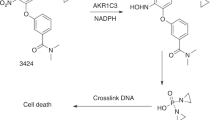Summary
(NPAz2)2NSOAz (‘SOAz’) is the first of a new class of cytotoxic agents containing an inorganic heterocyclic ring system to enter clinical trial. It was used to treat 31 patients with advanced cancer by IV infusion over 30 min on days 1, 2, 3, and 4 of a 21-day cycle, which was postponed if necessary to allow for hematological recovery. A total of 46 courses evaluable for toxicity was given and the tumor response was evaluable in 21 patients. Seven dose levels, ranging from 25 mg/m2 to 300 mg/m2, were studied, with three to six patients at each level.
The only major toxicity was myelosuppression, especially thrombocytopenia, which was dose-limiting. Platelets decreased from the 14th day onward, with a nadir 4–5 weeks after administration. Leukopenia was less predictable and reached a nadir 3–5 weeks after administration. In most patients recovery was complete after 6–9 weeks. Myelosuppression was clearly cumulative in succeeding courses and proved irreversible in three patients. Anemia also occurred, but otherwise SOAz was remarkably well tolerated. There were no responses and no therapy-related deaths. The highest tolerated dose for patients who had received no or only minor chemotherapy prior to treatment with SOAz was 300 mg/m2, and that for heavily pretreated patients, 175 mg/m2.
Because of cumulative myelotoxicity phase II studies with SOAz are not recommended.
Similar content being viewed by others
References
Chernov VA, Lytkina VB, Sergievskaya SI, Kropacheva AA, Parshina VA, Sventtsitskaya LE (1959) The anticancerous activity of certain phosphonitril trimer and tetramer derivatives. Pharmacol Toxicol 22: 365
Kitazato K, Takeda S, Unemi N (1982) Effect of pentaziridinocyclodiphosphathiazene, a new antitumor agent with inorganic ring, on various experimental tumors. Otsuka Chemical Co., Tokushima, Japan
Labarre JF, Faucher JP, Levy G, Sournies F, Cros S, Francois G (1979) Antitumor activity of some cyclophosphazenes. Eur J Cancer 15: 637
Labarre JF, Sournies F, Cros S, Francois G, van de Grampel JC, van der Huizen AA (1981) New designs in inorganic ring systems as anticancer drugs. Antitumor activity of the aziridino (ethylene-imino) derivatives (NPAz2)2NSOX with X=F, Az, Ph. Cancer Lett 12: 245
Nakano S, Yamashita K, Kirihara Y, Kuwata M, Morita K (1982) Acute toxicity study of 1,3,3,5,5-pentaziridino-thia-2,4,6-triaza-3,5-diphosphorine-1-oxide, a new antitumor agent with inorganic ring in mice, rats and dogs. Otsuka Chemical Corporation, Tokushima, Japan
Rodenhuis S, Scaf AHJ, Mulder NH, Sleijfer DTh, Beneken genaamd Kolmer MH, Uges DRA, van de grampel JC (1983) Clinical pharmacokinetics of (NPAz2)2NSOAz, “SOAz”. Cancer Chemother Pharmacol 10: 174–177
Van de Grampel JC, van der Huizen AA, Jekel AP, Wiedijk D, Labarre JF, Sournies F (1981) Derivatives of cis-NPCl2(NSOCl)2 and (NPCl2)2NSOCl. XVI. The preparation of some aziridino (ethylene-imino) derivatives of (NPCl2)2NSOX (X=F, Az, Ph) with a potential anticancer activity. Inorg Chim Acta 53: L169
World Health Organization (1979) Handbook for reporting results of cancer treatment. WHO, Geneva (Publication no 48)
Author information
Authors and Affiliations
Rights and permissions
About this article
Cite this article
Rodenhuis, S., Mulder, N.H., Sleijfer, D.T. et al. Phase i clinical trial of (NPAz2)2NSOAz: ‘SOAz’. Cancer Chemother. Pharmacol. 10, 178–181 (1983). https://doi.org/10.1007/BF00255757
Received:
Accepted:
Issue Date:
DOI: https://doi.org/10.1007/BF00255757




